My Musical Career|Part Twenty-Nine
Touring with the Oslo Philharmonic Fall 1985 – Germany, Switzerland and Austria
In my last post in this series, I wrote about my first “big” tour with the orchestra to the United Kingdom. During the course of that tour we visited England, Scotland and Wales. Needless to say, other than marriage, the birth of my children and actually getting the job of principal timpanist of the orchestra, it was one of the most important experiences of my life. I enjoyed it so much, that I still recall key details of the tour as if they were yesterday, instead of over thirty-years ago. To tell the truth, the same holds true for just about every one of the twenty-odd international tours that the orchestra took during my decade and a half of service with the orchestra. There were many “run-out” tours – trips of one or two day’s duration to venues in Norway, and I will deal with them in a separate post.
The next international tour for the OPO (I will use the English abbreviation for Oslo Philharmonic Orchestra henceforth) was scheduled for the fall of 1985, almost one exactly one year after our successful tour to the UK. Our recordings of the Tchaikovsky symphonies (the Fourth and Fifth had already been released) were serving admirably as calling cards and created a great deal of interest in both Mariss Jansons and the orchestra.
If memory serves me correctly, both Mariss and the orchestra were under the management of Harold Holt, Ltd. Stephen Wright was the executive assigned by the firm to handle our account, and accompanied us on our tours at this time – he later formed a musical management firm of his own and took both Mariss and the orchestra on as clients.
The Winds of Change….
Management of the orchestra had changed by this time. Turi Ebbesen’s tenure as administrative director of the orchestra had ended earlier that year. She was succeeded by Trond Okkelmo, who remained in that position during the remainder of my tenure and beyond.
He was friendly, enthusiastic and I always enjoyed talking music with him, as I found him to be knowledgeable on the subject. I believe he retired from that position in 2000, about a year and a half after I left.
Another change occurred with the departure of Ove Brun as stage manager. He held that position at the time I joined the orchestra until the spring of 1985, when he left the orchestra’s employ. He was succeeded by Atle Opem, who still holds that position today. Atle was a big change from Ove. Ove was quiet, friendly enough, and spare in build and reserved in manner. Atle was almost the opposite. Gregarious, friendly and hard-working, he really made something of the job, which is saying quite a lot. Working with him over the space of many seasons, I came to appreciate what a blessing a good stage manager is. Our personalities are similar, and we clashed a bit at the beginning, but over time we became used to the way each other worked, and I’d like to think that we became good friends and colleagues. His was not an easy job by any stretch of the imagination. He was responsible for the stage setup at the time, and as there was no official librarian, also for the music being on the stands in a timely fashion. I am not sure who did the actual librarian’s duties at the time, but I think Terje Mikkelsen and Atle between them did the bulk of it. Both were trained musicians and knew the business.
He was also responsible for overseeing the instruments, cases, stage setups, etc. and transport for our tours, and he did remarkably well at the beginning with this first German tour, and only got better as time went on.
The tour – Itinerary and Preparations
The tour, as I mentioned above was to West Germany, Switzerland and Austria. If memory serves me correct (don’t forget this is nearly thirty –one years after the fact), the venues included the following cities in what was then West Germany (we were still about four years away from the fall of the Berlin Wall and the re-integration of the two Germanys): Bremerhaven; Wurzburg; Regensburg; Aachen; Switzerland: Berne; Geneva; Austria: Linz; and Vienna. There were a few other venues in there that I cannot quite recall, but these are the ones that stand out from that tour. The program for those concerts was built around two symphonies: Franck’s D minor Symphony, and Tchaikovsky’s Sixth Symphony, the
Pathetique. The usual excerpts from Grieg’s “Peer Gynt” in addition to the usual concerto with soloist rounded out the programs. I prepped the Hinger drums for their second international tour, making sure that the heads, still Remo hazies, were clear and that all the machinery worked properly. I consulted with Atle as to the packing of the instruments, and made sure my concert attire and stick cases were in their proper places. (That is one of the nice things about touring – your concert clothes, instruments, and sticks are the responsibility of others during transport and flight.) Then, it was time to get home and pack my personal luggage for the tour.
West Germany
The orchestra flew out of Oslo in the afternoon of a mid-to-late November day. SAS was the airline chosen to take us to our first destination, which was Bremerhaven, where we met our buses, which would transport us throughout our stay in the Federal Republic of Germany and Switzerland. I boarded a bus which was driven by a man called Harry. He was in his late forties – graying a little at the temples, but very proper and efficient in the method that one would associate with German people. His English was excellent, and he was an excellent driver. However he had one idiosyncrasy and that was that he was extremely picky about his personal space on the bus, particularly the rack compartment where he stored his case and personal items. In retrospect, our players should have been more considerate and left that space for him, but they got the lecture from Harry so often, that he became known as “Gale Harry” – that loosely translates from the Norwegian into English as “Mad Harry”. (The vowel a is pronounced ah in Norwegian, and the e at the end is sounded out as eh, so it would sound gah-leh).It really was a pity, because he was such a good driver. As a matter of fact, Harry was most resourceful and decisive. We were driving along a very narrow street in Regensburg, and the road was partially blocked by a Volkswagen. The street was so narrow that even a car partially blocking the street would not allow our large bus to pass. Harry stopped the bus, put it in park, picked out three of the burliest musicians on the bus and had them get out with him, and together, they picked up the car and literally carried it to the sidewalk, and we were on our way within minutes. Harry received a round of applause, and there was very little talk of “Gale Harry” after that.
Wurzburg
Wurzburg , a city located in the German state of Franconia once had Richard Wagner among its residents, albeit temporarily. We arrived after a snow storm, and conditions were wintry, but it was a charming and
attractive town. Unfortunately, we were not the main attraction the night that we gave our concert, as the new Concert Hall in the city center was being opened and the local orchestra was doing the honors. Our concert was relegated to a high school gymnasium of sorts, but we were assured by both Stephen Wright and the local concert promoters that anyone who really mattered would be at our concert, as only the politicians from Wurzburg and other officials would be at the new hall. It turned out that they were correct, as our venue was filled to nearly overflowing. The concert was a great success, and we were heartened that we were so well-received at the start of our tour.
We had a free day after the concert, so many of us went into town to look around. I made a brief trip to the city center, then joined some friends for a tour of the Marienberg fortress (or Festung Marienber, as the locals call it) overlooking the city. The view from the entrance of the fortress
is rather spectacular, as it overlooks the entire city. The weather on our free day was good for that time of year, and you could really look right into the heart of the city, even though the fortress was at a distance. The hill that the fortress sits on is rather high.
Other Venues…
Other cities on the tour included Bremerhaven, Aachen, Regensburg as well as Geneva and Berne in Switzerland, and Vienna, Austria. Regensburg was notable for its large cathedral, which also has the largest organ in Germany. When I toured it on the afternoon of our concert day, they were actually digging part of the cathedral floor, as they had discovered some historical remains below the sub floor, so a portion of the church was roped off. However, it was a large cathedral, and reminded me of Cologne Cathedral, which has the tallest spires in Europe. It was also quite dark, as it was about four in the afternoon when I made my quick tour. Still, a most interesting building. Concerts at these venues were uniformly good. Transport between venues and a city were by bus, and with Harry at the wheel, was most efficient.
Switzerland
For me, this tour marked the first time I ever set foot in Germany, Switzerland and Austria. Switzerland I found to be very picturesque and the view of the Alps from both the plane and the bus windows was truly magnificent. If memory serves me correctly, we gave concerts in two cities: Geneva; and Bern (the capital city). Switzerland is a country that is multilingual. In Zurich and Bern, German is spoken, whereas in Geneva French is the language spoken. There are areas of Switzerland in which Italian is the main language. Truly an interesting country from a linguistic point of view. I found it to be a clean country, and as I said earlier, quite picturesque.
In Geneva, we played our concert in the Victoria Hall, which is the home of Switzerland’s famous L’Orchestre de la Suisse Romande, made famous by the long tenure of the late Ernest Ansermet as chief conductor the fifties and sixties. The acoustics were quite excellent, ands it was one of the prettiest concert halls that I had seen up to this point in my career. The concert was quite a success, and we had a day off to roam the city. Unfortunately, the weather was a bit on the brisk side, and as the city is very close to Lake Geneva, it was nippy to say the least. Food was excellent, as was the hotel. An interesting sidebar: While we were in Geneva, the famous first meeting between President Reagan and Soviet President Mikhail Gorbachev was taken place less than a mile from our hotel!
From Geneva, we traveled to Bern. Bern is the capital of Switzerland, and is surrounded by the Alps. On a clear day, the vista is quite magnificent. The buildings of the city were roofed, many of them, with red tile and gave the city a very picturesque quality. The concert there went well, but for me, what was special about Bern was the view from the top of the cathedral. The building dominates the city, and the
view is spectacular. This is especially so on a clear day and it was a glorious morning with full sunshine when I climbed the tower. Unfortunately, I went up a little too early as the morning haze had not completely burned off. But it was clear enough to see all the way to the Bernese Oberland! Beautiful, indeed.
Vienna…. Wien….City of Music!
We started off our visit to Austria with a concert in the city of Linz. It was an overcast wintry day, and we really did not have much time in Linz. We played our concert in the home of the Bruckner-Orchestra of Linz, and moved on to Vienna. I would get to know Linz a bit better on later visits. Vienna was the high point of our tour. This was the orchestra’s first visit to the city of wine, women and song, and as a history buff (both musical and political), this was like being let loose in a candy shop. Who hasn’t read about Vienna and all the famous musical and histori c cal figures associated with the city? To look at it at first blush, it isn’t
particularly a lovely city. Indeed, at first blush, it appeared to us as quite drab. This is particularly true after the first snow of the season had fallen, and by this stage of the tour it was early December and we were playing our final concert of the tour in the famous Muskikverein. This hall is, like Carnegie Hall in New York, a Mecca for orchestras. To be able to say that you have played here is saying something, and to have been asked back is something even greater. The concert was sort of a test for the orchestra and Mariss, as the goal of our tour was to be asked back for future concerts. Everyone in the orchestra was prepared, and all gave 110 percent! The acoustics of this hall are extremely good, and all of us reveled in the experience. If I am not mistaken, Tchaikovsky No. 6 was the main work on the program, which also included music by Grieg (Peer Gynt and the Piano Concerto). The audience gave us a fifteen-minute standing ovation, which was truly amazing. My colleagues in the orchestra, and specifically the percussion section, Per Erik Thorsen, Trygve Wefring, Per Mesæter and Bjørn Løken were equally astonished at the warmth of the reception. We had clearly made an impression, and concluded the tour on a very high note, indeed.
The nice thing about ending the tour in Vienna was that we had at least one full day to tour, and I walked
around the Ring, and visited St. Stephen’s Cathedral. I climbed the lower tower, which actually houses the famous bell “Pommerin”. The view from the lower tower allows one to look over most of the city. It would have been better if it were earlier in the fall rather than December, but it was still quite a sight! I also visited the Hotel Sacher for my first tast of Sachertorte and hot chocolate “mit schlag!” Delicious! A great way to finish a delightful tour!

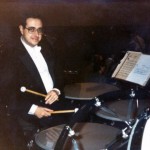
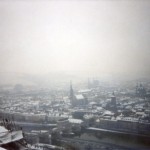
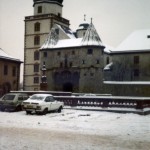
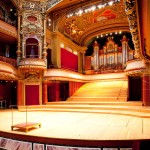
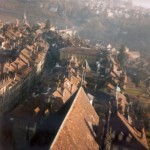
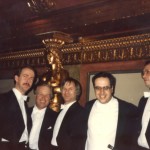
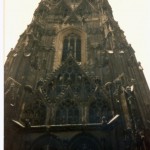
Recent Comments